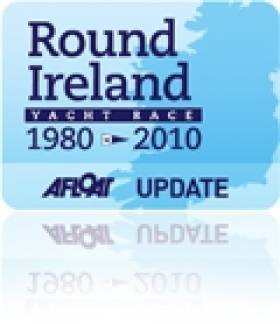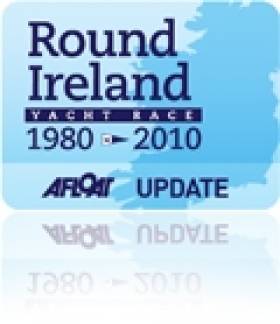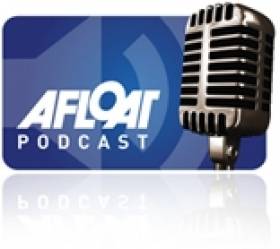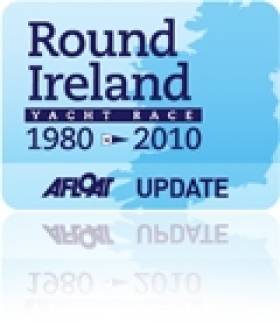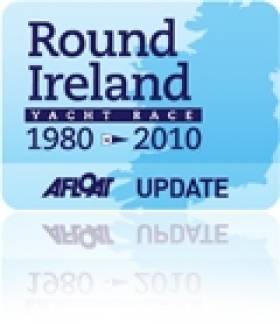Displaying items by tag: Round Ireland Race 2010 Wicklow Sailing Club
Slow Finish for Round Ireland
There was no deluge of overnight finishers, no sing of meteorological miracles or surging mass of racers passing Howth and heading on to Wicklow as the final stages of the Round Ireland slowed to a crawl in the short hours of darkness. The tracker shows plenty of boats stopping, spinning, and presumably anchoring off the coast of Northern Ireland as the wind dropped to a zephyr and the tide pulled at the fleet like toy boats in a draining bath.
But, firstly, Afloat.ie offers official congratulations to Tonnerre de Breskens 3, now sitting pretty in Wicklow with the major challenges to their title punctured below the waterline. Their race was near impeccable, and they add the Round Ireland win to their recent string of RORC offshore victories. To them, the glory, and it is all well deserved. Your correspondent pegged them as favourited, despite the Water Rat's predictions that Inis Mor had more in store.
Inis Mor, as it happens, slipped quietly into harbour yesterday evening at 7.38pm to take second overall. Then an overnight lull in finishers was broken by Fujitsu coming home at ten minutes to five, followed by the impressive young crew of Pride of Wicklow at ten to six, who drew a roar of appreciation from those waiting on the quays. Visit Malta Puma were next in at 6.35, and now the long wait for the next finishers, a trio of Aquelina, Bejaysus and Daft.com.
Cavatina's hoped-for intervention failed to materialise, and they have yet to cross the mouth of Belfast Lough, having spent the night close inshore where they could anchor against the tide.
Indeed there's a long way to go for those still out on the racecourse. A string of ten boats are crossing Dundrum Bay off Newcastle, with the rest in a cluster near Cushendall. For some of these competitors, depending on the weather, the race could last close to a full week, if they persist.
A word of congratulations to Wicklow town for making a proper festival of the race this year and showing its potential for growth. Official figures suggested 10,000 people hit Wicklow last weekend, but those involved were ebulliantly talking it up to 15,000 or more, which is no small achievement. It goes to show that despite its status as a sport that's not built for spectators, everyone loves to party with sailors.
Questions have been raised about the future of the race, however, in today's Irish Times. Article HERE.
Have your say on the racing in our forum thread HERE.
The race tracker is HERE, and the official site is HERE.
More on the Round Ireland Yacht Race:
Round Ireland Yacht Race 2010 Review
Round Ireland Yacht Race, Ireland's top offshore fixture
A Round up of 80 stories on the 2010 Round Ireland Yacht RaceGalileo Reports In From Off Cork Coast
Galileo have reported in via Afloat's free crew podcasting solution (details HERE) to say that they are making good headway off Youghal in the Round Ireland Yacht Race. Things are getting tricky up front with the leaders trying to judge the layline for the Fastnet rock, the next turning point at which the true placings will be judged. Inis Mor still hugs the coast, with the boats further offshore throwing in several tacks, and Tonnere de Bresken's lead shortened to just under 11 miles.
Round Ireland Yacht Race Countdown Begins
With 10 days to the off, Wicklow is gearing itself up for a bumper weekend of activity both on and off the water as the 2010 Conway Media Round Ireland Yacht Race comes to town on Sunday 20th June. This year will see the 30th renewal of the prestigious event.
With 34 entries so far, race organiser, Dennis Noonan (running his 6th event) is confident there will be close to 40 boats on the start line. The largest boat entered to date is Celtic Spirit of Fastnet, a sturdy 72’ Cruiser/Racer which has been to the Antarctic in the recent past. Just behind them we have a real flying machine, Pride of Dalkey, an IMOCA 60, which will be expected to take line honours.
With boats from France, Netherlands, UK as well as all coasts of Ireland, this promises to be an interesting race. Cavatina has appeared to try and get that elusive 3rd win and failing that, we are guaranteed a new name on the trophy, as it is the only previous winning boat entered.
Local boats are Pride of Wicklow, Noonan Boats Oystercatcher, both flying the WSC burgee and James Tyrrell’s latest Aqualina from Arklow. Major focus will also be on Daft.ie with Mick Liddy and blind sailor Mark Pollock on board their two-hander.
Sailing schools are also featuring with double entries from both Sailing West, Dun Laoghaire, Sailing Logic from the Hamble and a single boat from Conwy Yachting in North Wales.
As before, armchair spectators can follow the Conway Media Round Ireland Yacht Race on our Tracking system, supplied by RORC, through the race website: www.roundirelandyachtrace.ie
To coincide with the launch of the race Wicklow Town will have a huge amount of varied entertainment for families, sailors and more mature visitors through the Round Ireland Sail Fest, taking place from the 18th to the 20th of June. Free entertainment will include The American Drifters, The Garda band, Luan Parle and much more. For further information visit: www.roundirelandsailfest.ie
More on the Round Ireland Yacht Race:
Round Ireland Yacht Race 2010 Review
Round Ireland Yacht Race, Ireland's top offshore fixture
A Round up of 80 stories on the 2010 Round Ireland Yacht RaceTeam Oystercatcher, a double-handed entry in the Round Ireland race, are holding a charity fundraiser on Saturday the 12th June.
Bryan Byrne and Brian Flahive are competing on behalf of the National Children's Hospital and hope to raise at least €2,000 for the charity.
The event takes place at 7pm in the 40ft bar, and there will be a raffle for prizes on the night. The pair are hoping to see a large contingent from the Match Racing Leinsters joining them for the evening.
For those unable to attend, you can donate online by clicking on the link HERE.
Over 65,000 young people attend The National Children’s Hospital, Tallaght, every year.
The hospital prides itself on providing excellent care in a number of areas including, Endocrinology, Surgery, Radiology, Cystic Fibrosis, Diabetes, Asthma and allergies. There is also a very busy paediatric A&E department that sees over 30,000 children a year. The hospitals Outpatient department facilitates multidisciplinary care supporting its core services. Extensive research into the area of childhood illness is carried out in the hospital and Trinity College’s Paediatric Department is also based here.
Round Ireland Yacht Race Preview
In this week's podcast, we meet two very different teams taking part in the double-handed section of this year's Round Ireland Yacht Race, and MGM have their Used Boat Show in Dun Laoghaire.
Round Ireland Favourites Show Form
Two of the top entries in this year's Round Ireland race showed their form during the 230-mile Myth of Malham race at the weekend, with class wins for both Piet Vroon's Tonnerre de Breskens III and John Loden's HOD 35, Psipina. Loden joins half of the winning double-handed crew from the last Round Ireland, Paddy Cronin, for this year's race.
Tonnerre showed her pace, taking the overall IRC gong, while Psipina won the double-handed category of the race.
The 2010 Myth of Malham Race was a tough one. The challenging course around the Eddystone lighthouse was subject to two gale warnings and, as expected, there was a lumpy sea.
The race started in bright sunny conditions with a beat out of the Solent in a force four South Westerly breeze; but the fleet knew that it would get tough later. IRC classes Two and Three started first with Mark Tracey's J 109, Jamira, hitting the line on port right on time. However she soon had to tack because of starboard boats and John Loden's HOD 35, Psipsina, led the fleet down the Solent.
The second start saw the bigger boats fully powered up as they hit the line. With a strong tide running four boats were over the line early; three came back quickly but Steven Anderson's Encore took a long time to return and start correctly. Jonny Vincent's TP 52, Pace, powered away taking an early lead but Piet Vroon's Ker 46, Tonnerre de Breskens 3, managed to get in front of the other TP 52s and keep them behind.
Pace took line honours completing the 230 mile course in less than 23 hours but did not do enough to stop Piet Vroon and Tonnerre wining Class Zero and IRC Overall on handicap. After the race Mike Broughton, the navigator, explained their strategy. "The wind was remarkably stable and behaved as predicted so we worked the tides aggressively. We knew that, with half of the race being hard on the wind, Tonnerre would be hard to beat and she proved as fast as a TP 52 in the upwind conditions". Mike said that they were too fast to get perfect tides which he thought were well suited to a 40-footer. The only problem they had was a broken D1 which prevented them from tacking after the finish.
Tonnerre managed to keep Apollo and John Merricks II, the two other two TPs, behind her for the first three hours of the race and crossed the finishing line fourth, an hour and a half after Pace. Back in Cowes Piet joked that he was disappointed not to have finished in under 24 hours (they were 25 seconds over) as he waited for lower rated boats to finish. Piet considered that Erivale III, Mike Greville's Ker 39, was the most likely to beat him but in the event it was Marc de St Denis and Géry Trenteseaux's First 40, Courier de Coeur, which posed the threat. The Class One boat came second overall by just two and a half minutes on corrected time. "It was wet, cold and uncomfortable," said Piet. "We did a long leg out to sea to avoid the adverse tide at Portland and rounded the Eddystone at 0340. It was too close for a kite so we reached back under jib top and managed 18 knots on occasions. With the wind increasing it was a rough, uncomfortable and wet ride to the finish".
The overall results reflected the strength of IRC with boats from IRC Super Zero to IRC Two in the top six. Super Zero was won by Pace, Courier de Coeur took IRC One, Noel Racine's JPK 10.10, Foggy Dew, triumphed in IRC Two and IRC Three saw Jean Yves Chateau's Fastnet winning Nicholson 33, Iromiguy, take handicap honours. John Loden capitalised on his great start to win the Two-Handed Division in his HOD 35, Psipsina.
Alan Thornewill's MG 346, Spirit of Daedalus, was the last boat to finish nearly 24 hours after Pace. The race was toughest for the smaller boats which raced for twice as long as the big boats and they deserve credit for staying the course. The RORC would like to thank the volunteers and Brian Stewart, the owner, who kept Zulu the committee boat on station for a long watch. They were close to the lee shore and dragged the anchor as well as rolling heavily for the whole time.
More on the Round Ireland Yacht Race:
Round Ireland Yacht Race 2010 Review
Round Ireland Yacht Race, Ireland's top offshore fixture
A Round up of 80 stories on the 2010 Round Ireland Yacht RaceRound Ireland Offers Two for One Deal
There is only one week to go to enter the Round Ireland Race before a 50% late entry fee penalty applies. Wicklow Organisers are hoping for a fleet in excess of 40 boats to mark the 30th anniversary of the event and so far the east coast club are recording 19 entries. In a further initiative to bring in entries from across the Irish Sea and beyond, the Royal Ocean Racing Club fixture is offering a two for one deal for all overseas entries. The deal has been made possible through the Inter-reg project, Irish-Sea.org. Wicklow SC remind entrants that they are required to have a completed “RORC Checklist” prior to arriving for the event. A 50% Late Entry Fee will be applied to entries received after 8th June 2008
No entry will be accepted after Thursday 17th June 2010.
More on the Round Ireland Yacht Race:
Round Ireland Yacht Race 2010 Review
Round Ireland Yacht Race, Ireland's top offshore fixture
A Round up of 80 stories on the 2010 Round Ireland Yacht RaceNew Entrants in Conway Media Round Ireland
Among the entrants for the 2010 race are two identical yachts from Sailing Logic, based in the Solent, the leading yacht racing charter company in the UK. These are “Visit Malta Puma” (aka Puma Logic RORC Yacht of the Year 2009), skippered by Philippe Falle, with eight crew plus skipper and mate. The oldest member of the crew is Brian Philipps who is 70! The second Sailing Logic boat is “Jaguar Logic” skippered by James Allen who skippered ‘Me to You’ on the Challenge 2000 Race, and is Training Manager for Clipper Ventures. Again there is a crew of eight plus skipper and mate.
Enquiries from possible entrants in the race are welcome. Application forms and further details are available from [email protected] or Dennis Noonan Telephone: 01-2819459.
More on the Round Ireland Yacht Race:
Round Ireland Yacht Race 2010 Review
Round Ireland Yacht Race, Ireland's top offshore fixture
A Round up of 80 stories on the 2010 Round Ireland Yacht Race





























